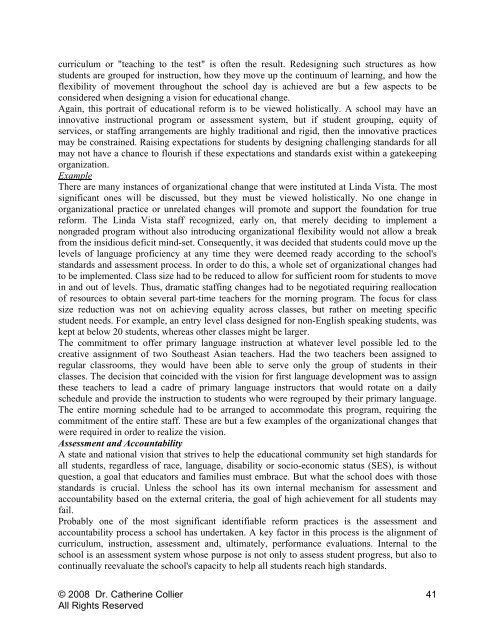Art Un ticle I.1 ited Sta In the ates News - Woodring College of ...
Art Un ticle I.1 ited Sta In the ates News - Woodring College of ...
Art Un ticle I.1 ited Sta In the ates News - Woodring College of ...
- No tags were found...
Create successful ePaper yourself
Turn your PDF publications into a flip-book with our unique Google optimized e-Paper software.
curriculum or "teaching to <strong>the</strong> test" is <strong>of</strong>ten <strong>the</strong> result. Redesigning such structures as howstudents are grouped for instruction, how <strong>the</strong>y move up <strong>the</strong> continuum <strong>of</strong> learning, and how <strong>the</strong>flexibility <strong>of</strong> movement throughout <strong>the</strong> school day is achieved are but a few aspects to beconsidered when designing a vision for educational change.Again, this portrait <strong>of</strong> educational reform is to be viewed holistically. A school may have aninnovative instructional program or assessment system, but if student grouping, equity <strong>of</strong>services, or staffing arrangements are highly traditional and rigid, <strong>the</strong>n <strong>the</strong> innovative practicesmay be constrained. Raising expectations for students by designing challenging standards for allmay not have a chance to flourish if <strong>the</strong>se expectations and standards exist within a gatekeepingorganization.ExampleThere are many instances <strong>of</strong> organizational change that were instituted at Linda Vista. The mostsignificant ones will be discussed, but <strong>the</strong>y must be viewed holistically. No one change inorganizational practice or unrelated changes will promote and support <strong>the</strong> foundation for truereform. The Linda Vista staff recognized, early on, that merely deciding to implement anongraded program without also introducing organizational flexibility would not allow a breakfrom <strong>the</strong> insidious deficit mind-set. Consequently, it was decided that students could move up <strong>the</strong>levels <strong>of</strong> language pr<strong>of</strong>iciency at any time <strong>the</strong>y were deemed ready according to <strong>the</strong> school'sstandards and assessment process. <strong>In</strong> order to do this, a whole set <strong>of</strong> organizational changes hadto be implemented. Class size had to be reduced to allow for sufficient room for students to movein and out <strong>of</strong> levels. Thus, dramatic staffing changes had to be negotiated requiring reallocation<strong>of</strong> resources to obtain several part-time teachers for <strong>the</strong> morning program. The focus for classsize reduction was not on achieving equality across classes, but ra<strong>the</strong>r on meeting specificstudent needs. For example, an entry level class designed for non-English speaking students, waskept at below 20 students, whereas o<strong>the</strong>r classes might be larger.The commitment to <strong>of</strong>fer primary language instruction at whatever level possible led to <strong>the</strong>creative assignment <strong>of</strong> two Sou<strong>the</strong>ast Asian teachers. Had <strong>the</strong> two teachers been assigned toregular classrooms, <strong>the</strong>y would have been able to serve only <strong>the</strong> group <strong>of</strong> students in <strong>the</strong>irclasses. The decision that coincided with <strong>the</strong> vision for first language development was to assign<strong>the</strong>se teachers to lead a cadre <strong>of</strong> primary language instructors that would rotate on a dailyschedule and provide <strong>the</strong> instruction to students who were regrouped by <strong>the</strong>ir primary language.The entire morning schedule had to be arranged to accommodate this program, requiring <strong>the</strong>commitment <strong>of</strong> <strong>the</strong> entire staff. These are but a few examples <strong>of</strong> <strong>the</strong> organizational changes thatwere required in order to realize <strong>the</strong> vision.Assessment and AccountabilityA state and national vision that strives to help <strong>the</strong> educational community set high standards forall students, regardless <strong>of</strong> race, language, disability or socio-economic status (SES), is withoutquestion, a goal that educators and families must embrace. But what <strong>the</strong> school does with thosestandards is crucial. <strong>Un</strong>less <strong>the</strong> school has its own internal mechanism for assessment andaccountability based on <strong>the</strong> external criteria, <strong>the</strong> goal <strong>of</strong> high achievement for all students mayfail.Probably one <strong>of</strong> <strong>the</strong> most significant identifiable reform practices is <strong>the</strong> assessment andaccountability process a school has undertaken. A key factor in this process is <strong>the</strong> alignment <strong>of</strong>curriculum, instruction, assessment and, ultimately, performance evaluations. <strong>In</strong>ternal to <strong>the</strong>school is an assessment system whose purpose is not only to assess student progress, but also tocontinually reevaluate <strong>the</strong> school's capacity to help all students reach high standards.© 2008 Dr. Ca<strong>the</strong>rine CollierAll Rights Reserved41
















